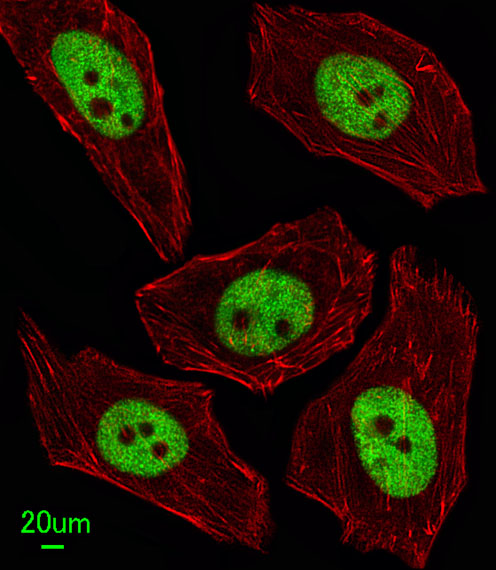产品名称
FEN1 Rabbit Polyclonal Antibody (Center)
别名
Flap endonuclease 1 {ECO:0000255|HAMAP-Rule:MF_03140}, FEN-1 {ECO:0000255|HAMAP-Rule:MF_03140}, 31-- {ECO:0000255|HAMAP-Rule:MF_03140}, DNase IV, Flap structure-specific endonuclease 1 {ECO:0000255|HAMAP-Rule:MF_03140}, Maturation factor 1, MF1, hFEN-1, FEN1 {ECO:0000255|HAMAP-Rule:MF_03140}, RAD2
存储缓冲液
Purified polyclonal antibody supplied in PBS with 0.09% (W/V) New type preservative N. This antibody is prepared by Saturated Ammonium Sulfate (SAS) precipitation followed by dialysis against PBS.
Human Gene ID
NP_004102.1
Human Swissprot No.
P39748
特异性
This FEN1 antibody is generated from rabbits immunized with a KLH conjugated synthetic peptide between 243-272 amino acids from the Central region of human FEN1.
运输及保存条件
Maintain refrigerated at 2-8°C for up to 2 weeks. For long term storage store at -20°C in small aliquots to prevent freeze-thaw cycles.
背景介绍
FEN1 removes 5' overhanging flaps in DNA repair and processes the 5' ends of Okazaki fragments in lagging strand DNA synthesis. Direct physical interaction between this protein and AP endonuclease 1 during long-patch base excision repair provides coordinated loading of the proteins onto the substrate, thus passing the substrate from one enzyme to another. This protein is a member of the XPG/RAD2 endonuclease family and is one of ten proteins essential for cell-free DNA replication. DNA secondary structure can inhibit flap processing at certain trinucleotide repeats in a length-dependent manner by concealing the 5' end of the flap that is necessary for both binding and cleavage by the protein encoded by this gene. Therefore, secondary structure can deter the protective function of this protein, leading to site-specific trinucleotide expansions.
细胞定位
[Isoform 1]: Nucleus, nucleolus. Nucleus, nucleoplasm. Note=Resides mostly in the nucleoli and relocalizes to the nucleoplasm upon DNA damage
功能
Structure-specific nuclease with 5'-flap endonuclease and 5'- 3' exonuclease activities involved in DNA replication and repair. During DNA replication, cleaves the 5'-overhanging flap structure that is generated by displacement synthesis when DNA polymerase encounters the 5'-end of a downstream Okazaki fragment. It enters the flap from the 5'-end and then tracks to cleave the flap base, leaving a nick for ligation. Also involved in the long patch base excision repair (LP-BER) pathway, by cleaving within the apurinic/apyrimidinic (AP) site- terminated flap. Acts as a genome stabilization factor that prevents flaps from equilibrating into structurs that lead to duplications and deletions. Also possesses 5'-3' exonuclease activity on nicked or gapped double-stranded DNA, and exhibits RNase H activity. Also involved in replication and repair of rDNA and in repairing mitochondrial DNA.



